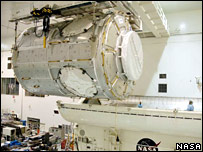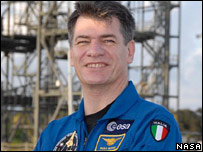Europe launched a campaign to conquer new space
After more than a decade of preparation, 45 tons of European equipment will be phased out into space within the next four months, including the " jewel " of the former continental universe - the Columbus laboratory. This laboratory will be installed as part of the international space station (ISS).
Europe has spent more time and money than expected to participate directly in this space station. Project Manager of the European Space Agency (ESA) Alan Thirkettle said that since 1995, they have spent about 5 billion euros (about 3.5 billion pounds, equivalent to 7 billion USD) for the chapter. submit.

Italy's Harmony junction will be launched next week.(Photo: NASA)
This money is used to pay more than 5000 employees and deal with over 50 companies. Many of these companies have sold their space station technology in the form of commercial products or services.'It's a big sum, but when you put it in context, it's not too much,' said Thirkettle.
Expenses have increased significantly after two missed schedules for the construction of the space station: The first hiatus was between 1996 and 2000. At that time, the Russian side did not keep up with the main control module named Zvezda. The second hiatus was in 2003, when Columbia was in distress (5 of the 7 astronauts died).
The US Universe (NASA) spent three and a half years with more than a billion dollars to fix the shuttle for the purpose of perfecting the space station.
Now G points
Next week, astronauts on Discovery, including Italian astronaut Paolo Nespoli, will install a corridor to anchor Europe's Columbus lab and Japan's Kibo complex to the station. .
'When Columbus got there, we would be part owner of a space station and this was very important,' said Thirkettle. He was at the Kennedy Space Center to prepare for the launch.

ESA astronauts like Paolo Nespoli have a very important mission.(Photo: NASA)
ESA takes part in the program led by NASA and Roskosmos (Russian Space Agency) for many purposes. Mr. Thirkettle said the program stimulates young people to study science and technology.'We will not develop it into a travel and financial service center , ' he said.
Europe also hopes
Europe also expects some groundbreaking results from investing in space in a number of areas such as medicine, technology, chemicals, liquid physics, biology and material science.
Europe's space research program is quite rich but also very focused. Mr. Thirkettle said crew-related health problems such as osteoporosis also provide suggestions for ground-based scientists.
Other experiments will focus on the study of new materials, such as materials used in manufacturing ultra-light rotors to increase the performance of aircraft engines. ' After 10 years of hard work with this project, this is indeed a climax, ' said Thirkettle. 'Finally, we are going to have high-level scientific research opportunities like Columbus' design goals.
The mission of European travelers

Columbus Station is in the final preparation phase and will be launched in December. (Photo: NASA)
Former continent astronauts received a series of long missions on the space station. First, French astronaut Leopold Eyharts, who will fly in the first flight to bring Columbus to orbit in December.
'We expect ESA astronauts to work on their own,' said astronaut Thomas Reiter. The astronaut is managing space research and development at the German Aeronautics Center.
ESA began a space station research program by sending a long-time Reiter astronaut last year. Earlier, the astronaut flew to Russia's Mir space station.'The current space cooperation is remarkable, although there are some minor issues here,' Reiter said. 'The European community can reap a lot in technology if supported'.
Dong Quang
- ESA announced the mission to conquer new space
- By 2022, China will have the first international space station
- Europe successfully launched transports into orbit
- Vancouver organized an AIDS campaign
- Russia recruited new space pilots for the mission to conquer the Moon
- Japan launched an energy saving campaign in the summer
- Europe launched the ship Edoardo Amaldi onto the space station
- India will conquer Mars
- Russia launched a new telecommunications satellite for Europe
- Received the first signal of Galileo satellite
- The US revealed plans to re-conquer the Moon
- China launches detox ... Net -
 Van Allen's belt and evidence that the Apollo 11 mission to the Moon was myth
Van Allen's belt and evidence that the Apollo 11 mission to the Moon was myth The levels of civilization in the universe (Kardashev scale)
The levels of civilization in the universe (Kardashev scale) Today Mars, the sun and the Earth are aligned
Today Mars, the sun and the Earth are aligned The Amazon owner announced a secret plan to build a space base for thousands of people
The Amazon owner announced a secret plan to build a space base for thousands of people The Heartbreaking Truth Behind the Astronaut Job That Many People Dream of
The Heartbreaking Truth Behind the Astronaut Job That Many People Dream of  'Strange smell' detected on cargo spacecraft to ISS
'Strange smell' detected on cargo spacecraft to ISS  After 4 years of being sent into space by Elon Musk, what is the fate of the $100,000 Tesla Roadster now?
After 4 years of being sent into space by Elon Musk, what is the fate of the $100,000 Tesla Roadster now?  The Shape of the Universe Isn't What You Think: From Ancient Round Sky to Modern Three-Dimensional Donut
The Shape of the Universe Isn't What You Think: From Ancient Round Sky to Modern Three-Dimensional Donut  How to get back to the spacecraft if the astronauts leave the cabin to work and accidentally drift away?
How to get back to the spacecraft if the astronauts leave the cabin to work and accidentally drift away?  Announcement of discovery of micro-asteroid population in the Solar System
Announcement of discovery of micro-asteroid population in the Solar System 